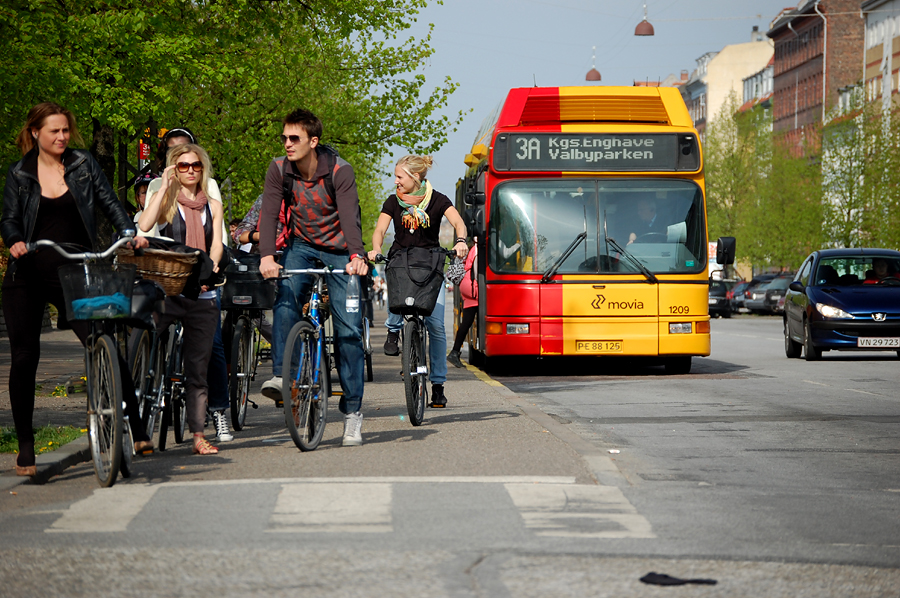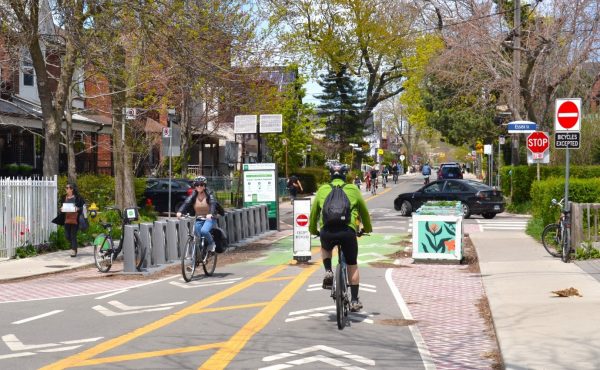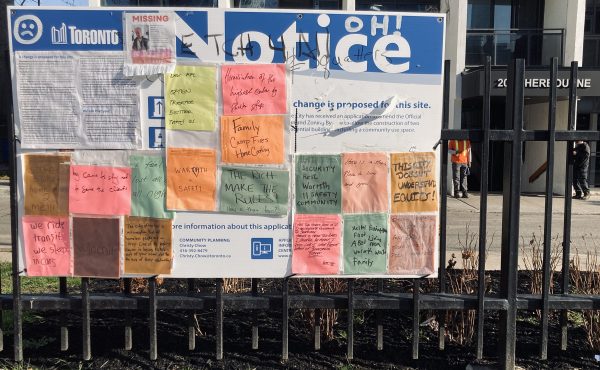
EDITOR’S NOTE: This is part two of a two-part series on Complete Streets. Check out Hilary’s first post from May 23, 2010.
![]()
If we want Toronto’s streets to be complete how do we build them?
The take home message from TCAT’s Complete Streets Forum was that inclusive discussions build ideas and social capital in a way that exclusive tactics simply can’t. We build complete streets with public support, political leadership and effective implementation of provincial and municipal policies. We build complete streets with both fundamental and incremental approaches to change.
Building public support for complete streets is the first and most important step. “The street is a major component of the public realm,” argued Antonio Gomez-Palacio of the Office for Urbanism. “When built properly, the street becomes the destination for the community.” Celebrating these possibilities for our streets shifts the conversation away from conflict and deficiencies towards a shared vision of what is possible.
To aid in this effort, Barbara McCann, Executive Director of the Complete Streets Coalition, suggested that community organizers use local photographs to inspire citizens as to how their streets could better meet their needs. “Local examples allow us to see the city in a new way, to relate everyday experiences to policy decisions. By reaching people from all walks of life, we create a powerful constituency for change.” McCann has built a strong coalition south of the border, including advocates from the Association of Retired Persons, the American Heart Association and the Association of People with Disabilities.
Complete streets already have political allies in southern Ontario. Toronto Mayor David Miller counts himself as one of them. “We actually can make the changes we want in this city if we believe in it,” said Miller during his opening address. Miller highlighted the connections between complete streets and Transit City – citing bike lanes along the Eglinton LRT corridor as an example of multi-modal transportation planning. While the effort to complete Toronto’s streets will outlast his term as Mayor, Miller encouraged participants to advance the complete streets concept through the City’s Public Realm Office.
At the municipal level, McCann encouraged decision makers to engage their communities about their vision for the streets. She emphasized the importance of addressing the needs of all users, embracing the particularities of our neighbourhoods and formalizing the process for policy exemptions. “Effective complete streets policies restructure the procedures, policies and programs to which our streets are subject,” says McCann. “They rewrite design manuals and standards, offer training opportunities to municipal staff and create new performance measures to evaluate success.”
At the regional level, key public servants are tuned into the need for complete streets planning. Leslie Woo, Vice President of Policy and Planning at Metrolinx, is among them. “A culture of active transportation is essential to public transit success,” said Woo. “All transit users are pedestrians first. We need to capitalize on the 80% of residents in the GTAH who live within walking or biking distance of a rapid transit route by making our stations mobility hubs. With the right infrastructure choices we can help to create seamless transitions between modes and jurisdictions in the region.” Woo identified specific strategies, like pedestrian corridors across busy streets and bicycle parking, being employed at the Kipling and Cooksville GO Stations.
The province is thinking about complete streets too. Jamie Austin of the Ontario Growth Secretariat (Ministry of Energy and Infrastructure) proudly showcased the complete streets-friendly elements of the Growth Plan for the Greater Golden Horseshoe. Mandated population and employment density targets, he argues, will help to build “dynamic, complete and connected communities”. The vision for complete streets in complete communities is there but the Growth Plan lacks the teeth to guarantee this kind of development across the region. All the while, Woo pointed out, “we continue to confront the challenges of a lost generation of investment.”
We are left with two mutually reinforcing approaches to completing our streets. The first is a fundamental shift in the way that we live and move. The second is an incremental course of action.
“We’ve been hitting the bullseye of the wrong target,” said Geoff Noxon of Noxon Associates. “Carefully considered decisions have led us to where we are today. We believed that sprawling cities filled with cars meant prosperity. We believed that children were safer away from the streets. Many are still aiming at the wrong target.” Noxon advocates for “biting off more than we can chew rather than nibbling around the edges”. That means redefining the problem from one of increasing road capacity to diversifying the range of choice for getting around. Equally, it requires us to identify new ways to define and measure success.
Yet with an enormous existing car-centric infrastructure, change is bound to be slow. Buy-in may not come as quickly as we hope, the funding for re-allocation may not be available right away. These roadblocks shouldn’t stop us from moving forward, according to Fiona Chapman, Manager of Pedestrian Projects for the City of Toronto. “We need to start somewhere. Getting projects on the ground creates powerful examples of change that citizens can interact with. Pilot projects let politicians off the hook. We can say, ‘This is a one off. Let’s just try it.’ There’s a different level of political investment in a pilot project and they allow us to understand how we’ve been effective and what we can do better next time.”
Andrew Wiley-Schwartz of the New York City Department of Transportation agrees. A pilot project his office initiated to close traffic on Broadway through Times Square yielded much needed public space, a 15 percent improvement in travel times and a 63 percent reduction in pedestrian injuries. “With some paint, tables, chairs and umbrellas, we were able to generate all kinds of dividends that delivered in a matter of months.” The city will now use routine resurfacing projects as an opportunity to make these pilot projects permanent. In the mean time, the city’s street design manual has changed to embed the complete streets ethos in future redevelopment initiatives.
Bit by bit, cities like New York can change the streetscape, demonstrating to politicians and the public alike that there is another way to build. Projects beget success, success begets further opportunities for change. Before you know it, you’ve got a network of streets that are accessible to the complete range of urban travelers.




6 comments
A HD video is worth a thousand pictures: A complete street in Amsterdam. Very zen.
We won’t get complete streets with endless chitchat and theoretical posturing. I just got back from New York and the transformation there is remarkable: it’s not just Times Square–there are bike lanes on the major avenues too and people are using them. And by the way I’ve never seen traffic run so smoothly there. Toronto is a hellhole of gridlock by comparison. The key is getting it right the first time so that there is no backlash–a perennial problem in Toronto. The guy in the article said it: all it takes is a few cans of paint.
Have to agree with RG. By the speed of things happening in Toronto, it will be generations before we get even close to where New York is right now, not to mention Copenhagen or Amsterdam.
Most major streets in the Toronto burb are wide enough. There should be enough room to paint a bike lane or build a raised one. In the core the streets are narrower, it is a bit complicated. I can think of several solutions:
1. get rid of on-street parking, it is such an archaic and small town notion, it should have no place in a big city. Where parking is needed, build parking structures, and yes, charge parking fee high enough to recoup the cost, and to discourage driving in core. It may be less convenient than on-street ones, but it is sickening to see two or three parked cars take over a full lane of an entire block. That is convenience for 3 persons, at the expense of many others, drivers and cyclists alike.
2. Convert streets to one way, like in Manhattan. New York can afford to do what they are doing, because of its extensive one-way street network. It is much feasible to take 1 lane out of 4 to convert to bike lane or do something else, while with a 2 lane two-way street you can only scratch your head.
It definitely starts with Richmond and Adelaide
but with more complete street ecologies –
those two streets are uber-business-only,
Meantime Dundas, Queen and King could be one way too, with some parking and bike lanes and full urban ecologies, with sidewalk life, merchants, and local residential vibrance.
Our big streets are positioned farther apart mostly so that north and south in Toronto are quite hard to rework – north of Wilson, Bathurst, Yonge and Bayview are too far apart to consider such treatment, unless we expropriate for sidewalks and drop in bikelanes – the boulevards are wider there, it is possible.
San Francisco has timed directional lanes on the bridge, like Jarvis, – maybe our Davenport, Caledonia – and Dufferin might work like that.
In this town it takes more than paint, but the core can be reworked that way and maybe that is where it is needed most.
Saying there should be complete range of options for all forms of transportation. And I would agree with that premise that there is vast room for improvement on that score. But saying that every street should provide the full range is something else. New York is a city that is frequently cited as a model on this site and yet it has a very robust network of one-way streets. If the Complete Streets advocates are saying that all streets should be all things (and that’s what some of them seem to be saying), then I feel they are being very simplistic.
If Miller et al are soo smitten with the concept of Complete Streets, why did he vote FOR the Bloor/Yorkvile project which essentially forgets about bikes, and precludes putting in the easy bike lanes by wasting the needed space between new planters and new curbs?
It’s truly disgusting, and ensures that some cyclists will ride on the very wide sidewalks, and others will be squished on the road, as I doubt very very very much that there will ever be the political will to reduce the car/motor travel lanes to a single one in each direction to give us the bike lanes, first suggested here as the #1 spot in 1992.
And for those concerned about privatizing of public space and keeping the public sidewalk, there’s the layby in front of Holt-Renfrews that kinda sets the tone for the project and for the City’s true priorities eh?
Since the City found another $5M for the project, they should find what another $1M-ish to rebuild the curb segment for this greenhouse century.